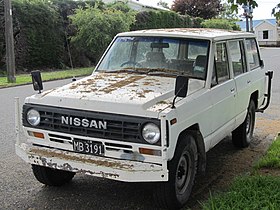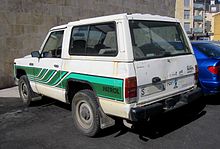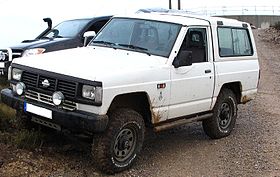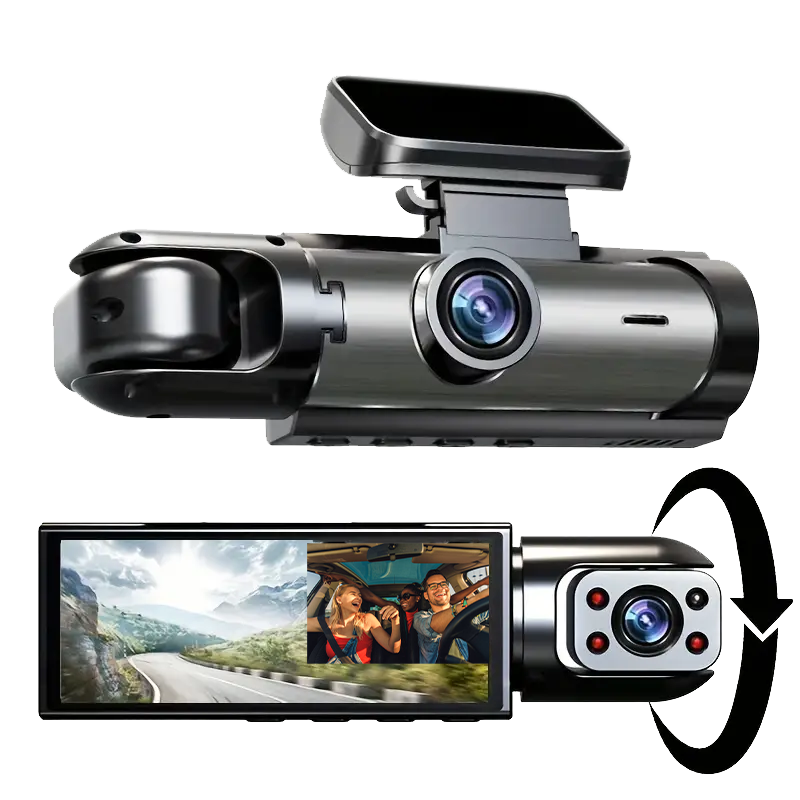
Nissan Patrol Third Generation 1980- 1989

| Third generation (160) | |
|---|---|
 |
|
| Overview | |
| Also called | Datsun Patrol Ebro Patrol Nissan Safari (Japan) |
| Production | 1980–1989 |
| Assembly | Japan: Hiratsuka; Kanda; Zama (1980–1987) Iran: Tehran (Pars Khodro; 1984–1989) South Africa: Rosslyn (1983–1991) Spain: Barcelona (1983–1988) |
| Body and chassis | |
| Body style | 3-door hardtop 3-door softtop 5-door wagon/van 2/4-door pickup fire truck |
| Layout | Front-engine, rear-wheel drive Front-engine, four-wheel drive |
| Powertrain | |
| Engine | 2.8 L L28/L28E I6 (petrol) 3.3 L SD33 I6 (diesel) 3.3 L SD33T I6-T also a 4.8 v8 note rare (diesel) 4.0 L P40 I6 (petrol) |
| Transmission | 4/5-speed manual 3-speed 3N71 automatic |

Nissan Patrol (Spain)
The 160 series was introduced in 1980 to replace the 60 series. In Australia, these are officially known as the MQ Patrol. In 1980, the engines available were the L28, P40 and SD33. All models were available with a four-speed manual transmission, albeit a three-speed automatic was optional on long wheelbase vehicles fitted with the L28 engine. All 160 series Patrols came with a two-speed offset transfer case, which featured a 1:1 high gear and a low gear.
All models had leaf sprung suspension. The SD33 vehicles feature 24-volt electrics. Different trim options and colors were available, with options including vinyl or carpet floors, and blue or brown interior trim. Air conditioning and power steering were available on deluxe models.
The front differential in all models was C200. In Australia, the standard rear differential was the H233. Some versions featured limited slip differentials (LSD). A heavy duty model rear differential was used in some pickup trucks and P40 engined wagons. This was the H260 model differential. In European markets, where less onerous off-road use was expected, the light duty C200 rear differential was installed in some vehicles.
In 1983, the MQ model was updated. These are commonly known as an MK Patrol, however this does not appear on any Nissan literature or service manuals. Nissan parts dealers do not recognise these initials either. Updates included revised front end with rectangular headlights and an upgraded front suspension. The four-speed gearbox was revised and a fifth gear was added for most models. The four-speed was still used in some lower specced utes, presumably to run out stock. A high roof ("Super Roof") version of the wagon was added at the same time, which was also when the SD33T turbodiesel option was first made available. With 110 PS (81 kW) the turbodiesel can reach 145 km/h (90 mph).
The naturally aspirated SD33 diesel engine was also updated at this time. Revisions included the use of three piston rings instead of five, piston oil squirters and spin on oil filter instead of a paper cartridge type. In Australia and some other parts of the world, the SD33-engined Patrols were also revised to standard 12-volt electronics. To accommodate the extra power of the turbodiesel engine, these models feature a larger clutch (270 versus 240 mm) and larger oil cooler (five rows versus three) than does the naturally aspirated version.
These were the last Patrols to carry the Datsun brand—in line with the rest of the Nissan lineup, the Patrol lost its Datsun branding in 1984 in most markets.
260 (1986–2002)
| Third generation (260) | |
|---|---|
 |
|
| Overview | |
| Also called | Ebro Patrol (Spain, 1986–1993) Sanxing Desert King (China) |
| Production | 1986–2002 |
| Assembly | Iran: Tehran (Pars Khodro; 1989–2000) Italy: Rome (1988–1993) Spain: Barcelona |
| Body and chassis | |
| Class | Full-size off road vehicle |
| Body style | 3-door hardtop 5-door wagon/van 2/4-door pickup |
| Layout | Front-engine, rear-wheel drive Front-engine, four-wheel drive |
| Powertrain | |
| Engine |
|
| Transmission | 5-speed manual |
| Dimensions | |
| Wheelbase | SWB: 2,350 mm (92.5 in) LWB: 2,970 mm (116.9 in) |
| Length | SWB: 4,230 mm (166.5 in) LWB: 4,690 mm (184.6 in) |
| Width | 1,689 mm (66.5 in) |
| Height | 1,980 mm (78.0 in) |
The 260 series was a Spanish-built version of the 160 (easily spotted by the rectangular headlamps) sold in Europe and was available in SWB and LWB with L28, SD33, RD28 and RD28T engines. The SD-engined version, at least in the UK market, had a 24-volt electrical system. Nissan Ibérica-built Patrols also received a Spanish-made Perkins diesel engine and Spanish transmission to meet local content regulations. It also helped Nissan Ibérica amortize plant investments. The 260 Patrol later received a facelift with a new grille similar to that of the Y60 series which succeeded this generation elsewhere. Spanish production continued until 1994 for export and until 2002 for the Spanish domestic market.
